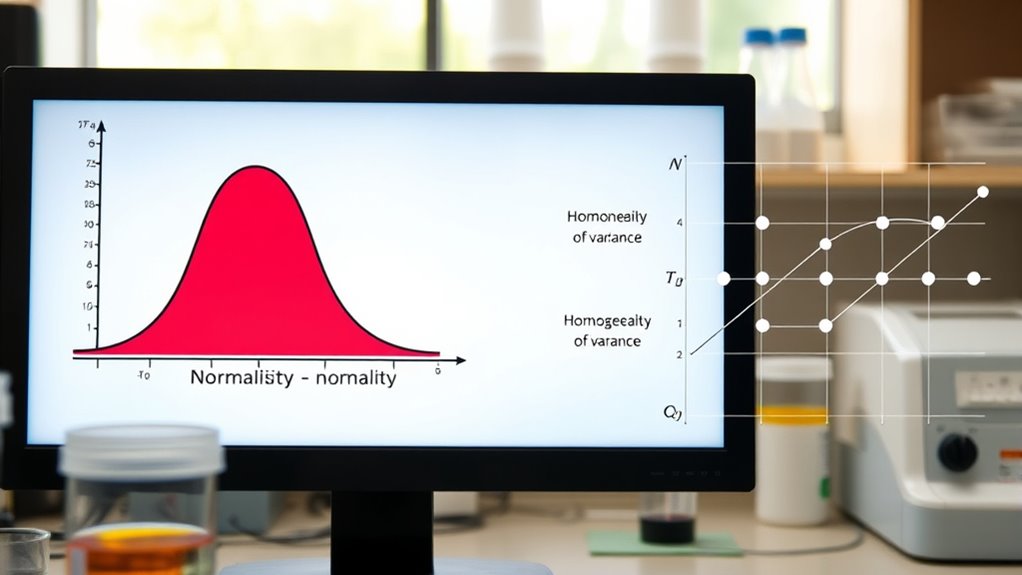When using parametric tests, you need to guarantee three key assumptions are met. First, your data should be normally distributed, which can be achieved by increasing sample size or applying transformations like log or square root. Second, the variances across groups should be similar; transformations or tests like Levene’s can help. Finally, your observations must be independent, meaning one doesn’t influence another. Understanding these basics helps you perform valid analyses, and exploring further will give you more confidence in your results.
Key Takeaways
- Parametric tests assume data are normally distributed, especially with small samples; larger samples often improve normality via the Central Limit Theorem.
- Homogeneity of variance requires similar variability across groups; violations can be addressed through data transformations like log or square root.
- Independence of observations means each data point is unaffected by others; violations bias results and cannot be fixed with transformations.
- Data transformations help normalize data and stabilize variances, making parametric test assumptions more valid.
- Ensuring proper study design is critical for independence, while adequate sample size and transformations aid in meeting normality and homogeneity assumptions.

Parametric tests are powerful statistical tools, but they rely on specific assumptions to produce valid results. One of the key considerations is sample size. If your sample size is too small, the test may not accurately reflect the population, leading to unreliable conclusions. Small samples often fail to meet the normality assumption because their distributions tend to be skewed or irregular. To address this, you might need to gather a larger sample or consider data transformation techniques that help stabilize variance and make data distributions more normal. For example, applying a logarithmic or square root transformation can reduce skewness, making your data more suitable for parametric analysis.
Small samples often fail normality assumptions; larger samples or data transformations can improve parametric test validity.
When it comes to normality, you need to assess whether your data follow a bell-shaped curve. If the data substantially deviate from normality, your test results could be misleading. In such cases, increasing the sample size can sometimes help, as the Central Limit Theorem suggests that the distribution of the sample mean tends to be normal with larger samples, regardless of the original data distribution. However, if increasing the sample size isn’t feasible, data transformation techniques become essential. These techniques can help make the data more symmetric and closer to normal, satisfying the assumptions and ensuring more reliable test outcomes.
Another critical assumption is homogeneity of variance, meaning that different groups or samples should have similar variability. If this assumption is violated, the test’s validity drops, and you risk drawing incorrect conclusions. To evaluate this, you can use tests like Levene’s or Bartlett’s. If variances are unequal, increasing the sample size might help, but often, data transformation techniques, such as a log or Box-Cox transformation, can equalize variances across groups. These transformations help stabilize the spread of the data, ensuring the assumption of homogeneity is met and enhancing the accuracy of your parametric tests.
Lastly, independence of observations is fundamental. Your data points must be collected in a way that one observation doesn’t influence another. Violating this assumption can severely bias your results, no matter how large your sample is. Ensuring independence often involves careful study design rather than statistical adjustment. If dependencies are present, data transformation techniques may not resolve the issue, and you might need to consider alternative statistical methods better suited for dependent data, such as mixed-effects models. Additionally, understanding the types of data suitable for parametric tests can help in designing studies that naturally satisfy independence and other assumptions.
Frequently Asked Questions
How Do Violations of Assumptions Affect Test Validity?
When assumptions are violated, it can compromise your test’s validity and reliability. Assumption violations may lead to inaccurate p-values, increasing the risk of Type I or Type II errors. This means your conclusions might be unreliable or misleading. To guarantee your results are trustworthy, you should check assumptions carefully and consider alternative methods or data transformations if violations occur, preserving your test’s validity and reliability.
Can Parametric Tests Be Used With Small Sample Sizes?
You can use parametric tests with small sample sizes, but keep in mind that sample size considerations impact their robustness. Small samples may not accurately reflect the population’s distribution, which can threaten the validity of your results. To improve reliability, guarantee assumptions are reasonably met or consider alternative non-parametric tests. Remember, larger samples generally increase the robustness of parametric tests, making your findings more trustworthy.
What Methods Are Available to Test Assumptions Formally?
Imagine your data as a puzzle 🧩—formal testing helps you verify if each piece fits. You can use shapiro-wilk or kolmogorov-smirnov tests for normality, Levene’s or Bartlett’s for homogeneity of variance, and the Durbin-Watson test to check independence. These methods enable assumption validation, ensuring your parametric tests are valid and reliable. Always perform formal testing before proceeding with your analysis to avoid misleading results.
How Do Non-Normal Distributions Influence Parametric Test Results?
Non-normal distributions can distort parametric test results by affecting distribution effects and skewness impact. If your data are heavily skewed or have outliers, the test may produce inaccurate p-values or confidence intervals. This happens because parametric tests assume normality; when this isn’t met, the test’s validity diminishes. To counter this, consider data transformations or non-parametric alternatives to guarantee more reliable, valid results.
Are There Alternative Tests if Assumptions Are Not Met?
If assumption violations occur, you can use robust alternatives that don’t rely heavily on normality or equal variances. Non-parametric tests, like the Mann-Whitney U or Kruskal-Wallis, are great options. They handle non-normal distributions better and are less affected by heterogeneity of variances. These alternatives help guarantee your results remain valid even when assumptions of parametric tests aren’t met.
Conclusion
Understanding the assumptions of parametric tests is like tending a delicate garden—you must nurture normality, guarantee homogeneity of variance, and respect independence to let your data flourish. When these conditions are met, your analysis is like a well-tuned symphony, harmonious and reliable. Ignoring them risks planting seeds of error, turning your statistical landscape into a wild jungle. So, tend these assumptions carefully, and watch your results grow with clarity and confidence.










